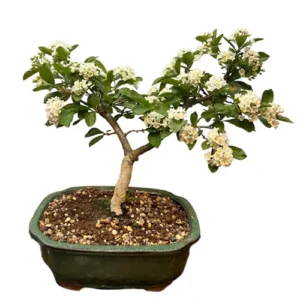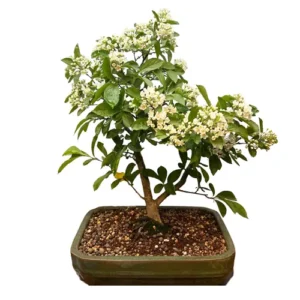Salix babylonica
Weeping Willow Bonsai
Native to northern China. Salix babylonica is a vigorous grower in both its foliage and its ever-spreading roots. This is one of the few Bonsai species that responds well to the weeping style.
Weeping Willow Bonsai Care Tips
Placement
Weeping Willow appreciate a sunny spot throughout the growing season but need some shade protection at the height of summer. A frost free greenhouse or shed is the ideal winter spot for a weeping willow.
Watering
Keep reliably moist but not waterlogged. During the hottest part of the summer, Weeping Willow will demand a lot of water, several times across a day. It may be worth placing the pot in a shallow bowl of water to stave off drought. In the winter keep the rootball moist, but water considerably less than the growing season.
Feeding & Fertilising
Every six weeks apply a solid organic feed during the growing season. Alternatively, use a liquid feed every fortnight. Avoid fertiliser rich in nitrogen.
Pruning & Wiring
Pruning your bonsai is important not only to create or maintain an aesthetic style but to also ensure optimal health. In early Spring, prune your Weeping Willows old branches so that new shoots can hang down. Throughout the growing season pinch out the tips of new shoots as they emerge. Leave only one leaf junction.
New shoots can be wired as soon as they have lengthened appropriately to train them to weep. Weighting the end of stems can help this process. Raffia should be used to protect the stems from scarring. Wires should be kept on throughout the growing season. We recommend using wires with a thickness that matches the thickness of the branch: if the wire you choose is too thick you will damage the bark. If it is too thin, it won’t be effective.
Repotting
Repotting your tree is an important way to provide a fresh and suitable soil mix and ensure appropriate root health. Weeping Willow bonsai are unique in that they grow so vigorously that the roots can threaten to break the pot holding it. Repot your Weeping Willow every year when the buds start to swell. A moderately Alkaline soil mixture will help, so feel free to add lime or pumice.
Trees that are ready for repotting will require root pruning, a suitable new pot and appropriate soil mix.
When repotting, do not cut back the root mass by a large amount, and choose a well-draining soil mix that has a neutral or slightly higher PH value of 5-6 but not over 7. We tend to use a mixture of different speciality bonsai soils on our trees. Every species is different so please contact us for free soil-mix advice or to take advantage of our repotting service.
Bonsai trees aren’t only magnificent additions to an indoor oasis, they are more than capable of standing out in any garden. Many Bonsai species are incredibly hardy and withstand nature’s colder and damper turns with aplomb making them worthwhile outdoor plants. We have an extensive library of care guides for outdoor bonsai trees. It’s not about selecting the perfect bonsai, it’s about selecting the perfect bonsai for you.
Weeping Willow Bonsai - Typical Queries
Do Weeping Willow get pests and diseases?
Weeping Willow can be bothered by several intruders. Scale, aphids, gall makers, gall mites and caterpillars can attack this bonsai. It can also incur rust and canker. The appropriate pesticides will tend to the pests.
How to propagate Weeping Willow bonsai?
The method of propagation for Weeping Willow is by cuttings. So potent are these cuttings they can even root in a glass of water. The ideal window to root cuttings is in June. Second or third-year growth is best used. Near any thick plant parts can be used as cuttings and produce roots.
Can you keep a Weeping Willow indoors?
As a hardy deciduous and a fast-growing one at that, it is best to keep a Weeping Willow outdoors. An outdoor spot with shade for half the day and sun for the other is ideal for this Bonsai.





















